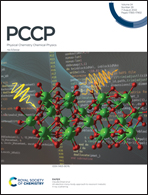Effects of vacancy defects on the magnetic properties of vanadium diselenide monolayers: a first principle investigation†
Abstract
Long-range ferromagnetic (FM) order in vanadium diselenide (VSe2) monolayers (MLs) remains a controversial subject. In this theoretical study, we examined the effect of vacancy defects on the magnetic properties of octahedrally coordinated 1T-VSe2 MLs using spin-polarized density functional theory (DFT). In total, 45 different kinds of defects with various concentrations were introduced, including two single vacancies (S), 27 double vacancies (D), nine triple vacancies (T), and seven quadruple vacancies (Q). To understand the magnetic properties, SSe, DSe-(10), TSe-(10)(10), and QSe-(21)(10)(10) were selected to be analyzed because they had low formation energies and large variations in magnetic moments (M). Compared with the perfect VSe2 ML, the values of the M of vanadium (V) decreased from 0.675 to 0.466, 0.183, 0.213, and 0.208 μB with increasing vacancy concentration. The same trend was also found for the energy differences between FM and antiferromagnetic (AFM) ordering. These results generally indicated weaker FM coupling and a lower Curie temperature in defective VSe2. Vacancy-induced lattice distortion, d orbital shifting, electronic occupation, and spin density redistribution were discussed in order to explain the above observations. Our investigation demonstrated a strong dependence of M and the magnetic interaction of VSe2 on the concentration and types of Se vacancies, which would explain the uncertainties encountered in magnetic experiments.



 Please wait while we load your content...
Please wait while we load your content...